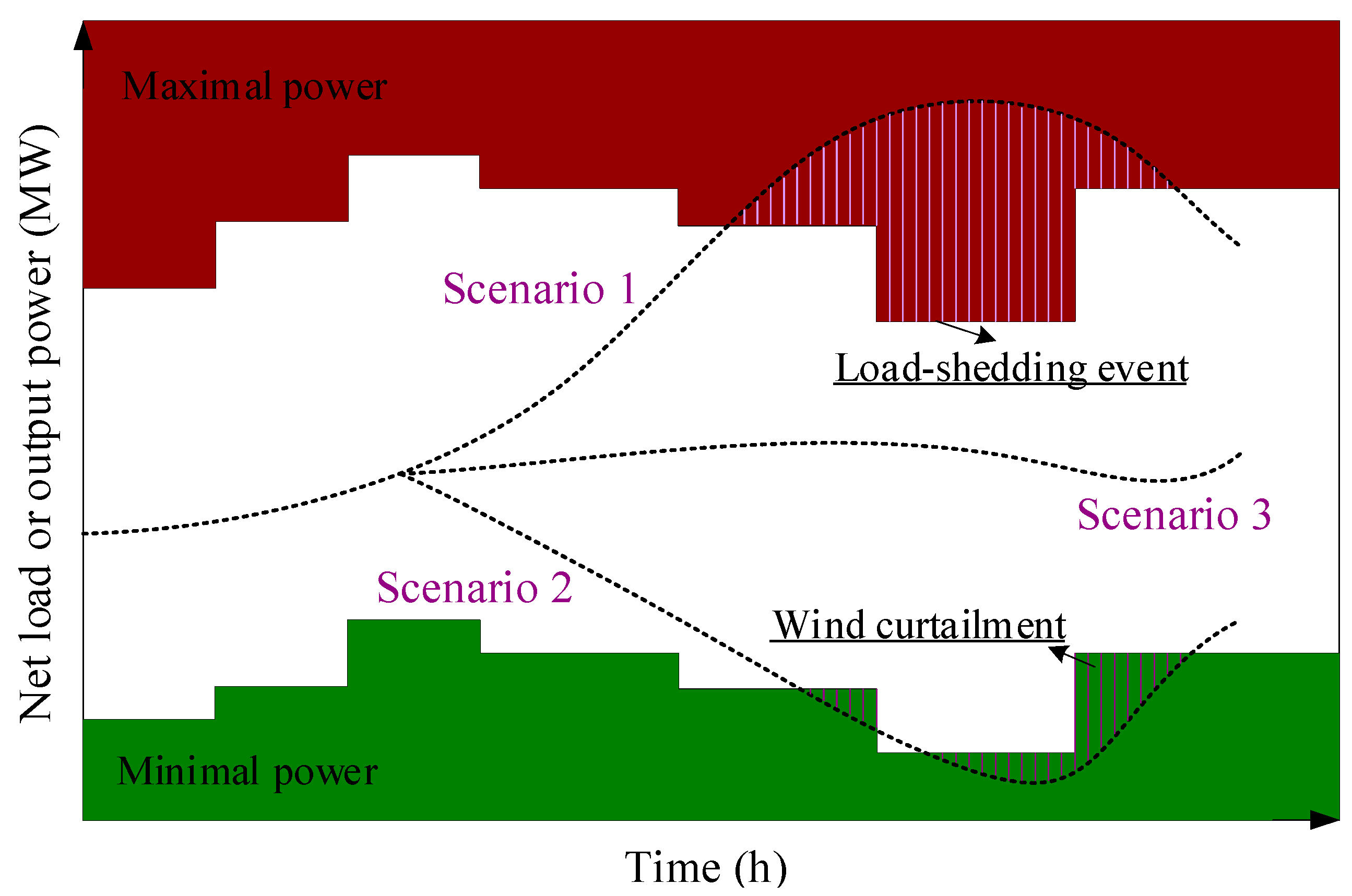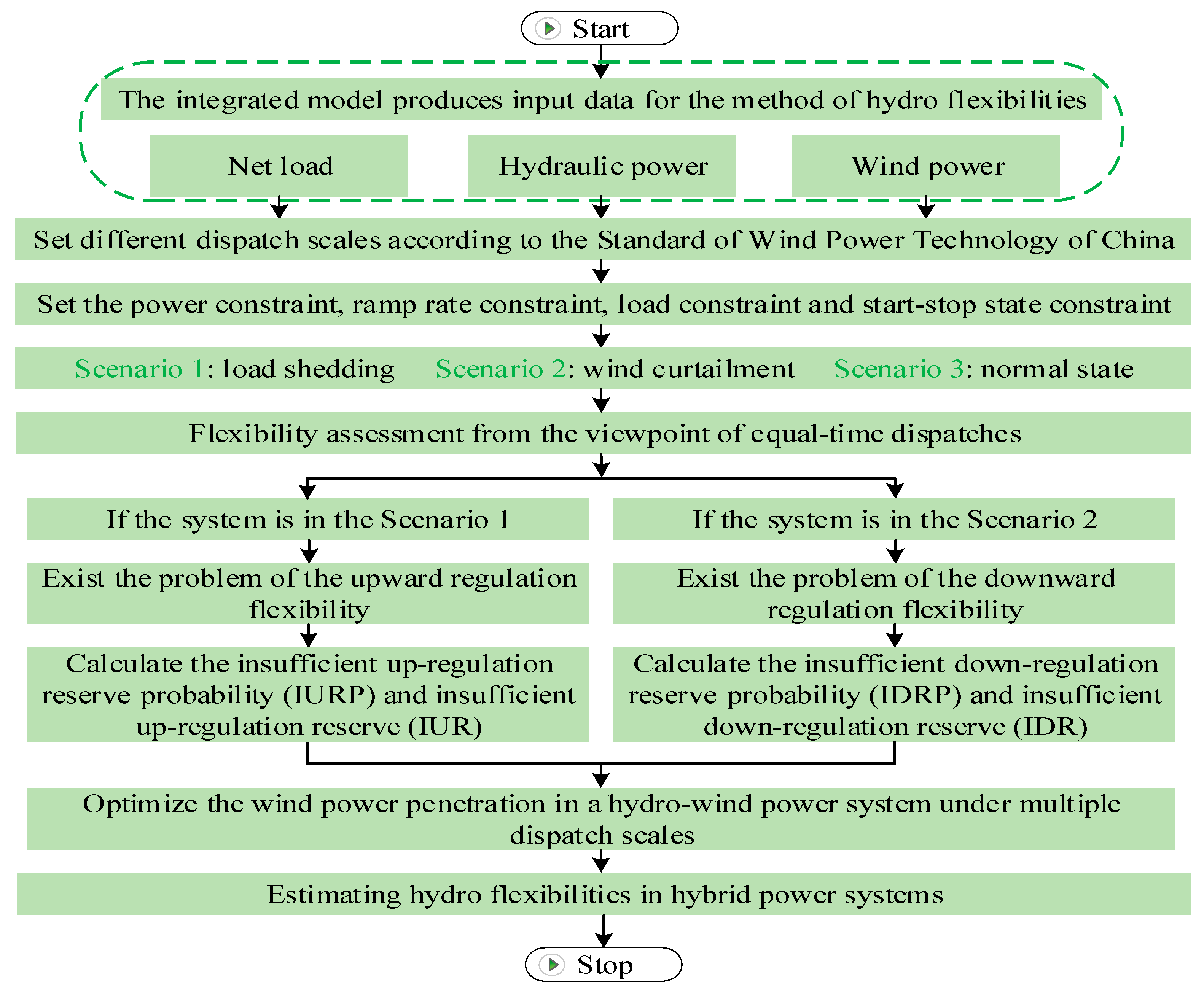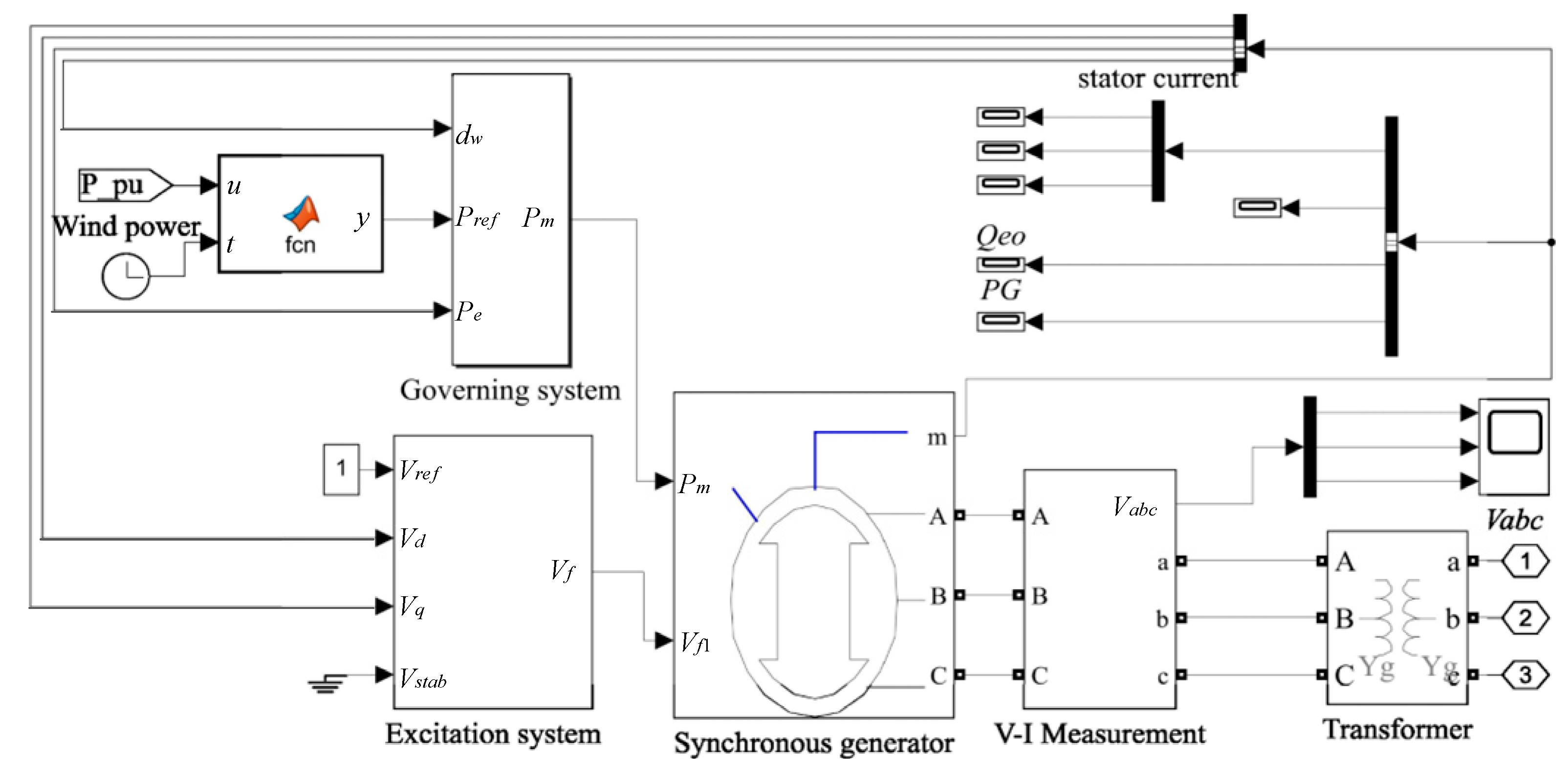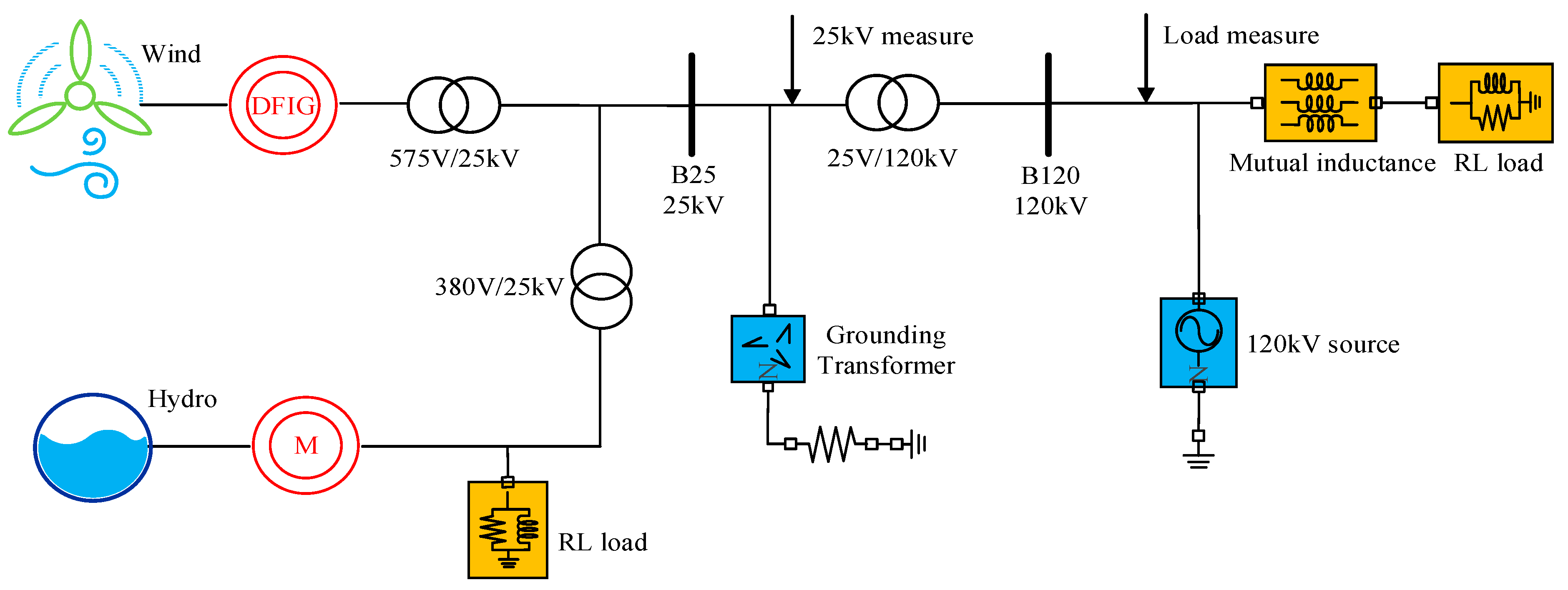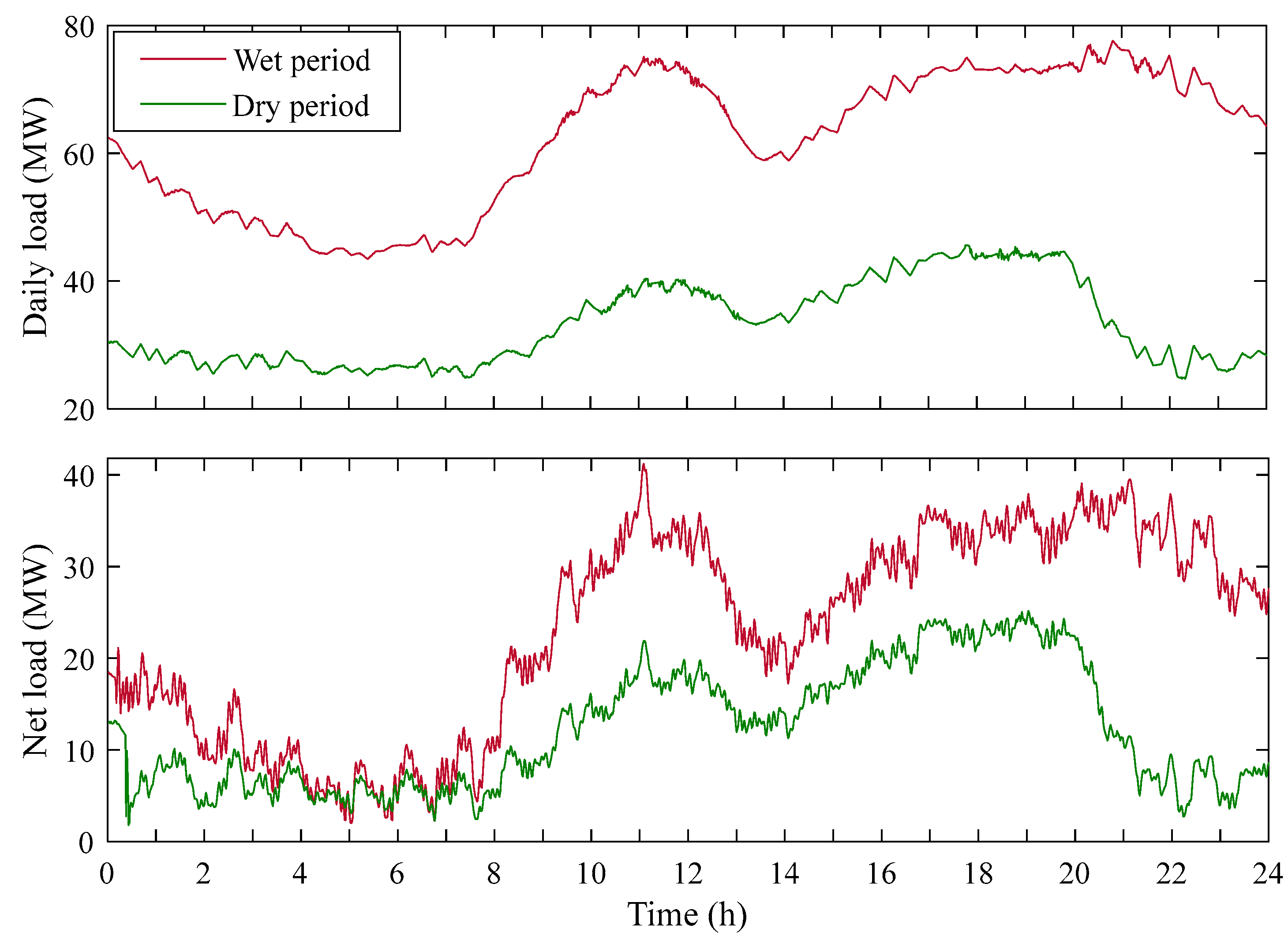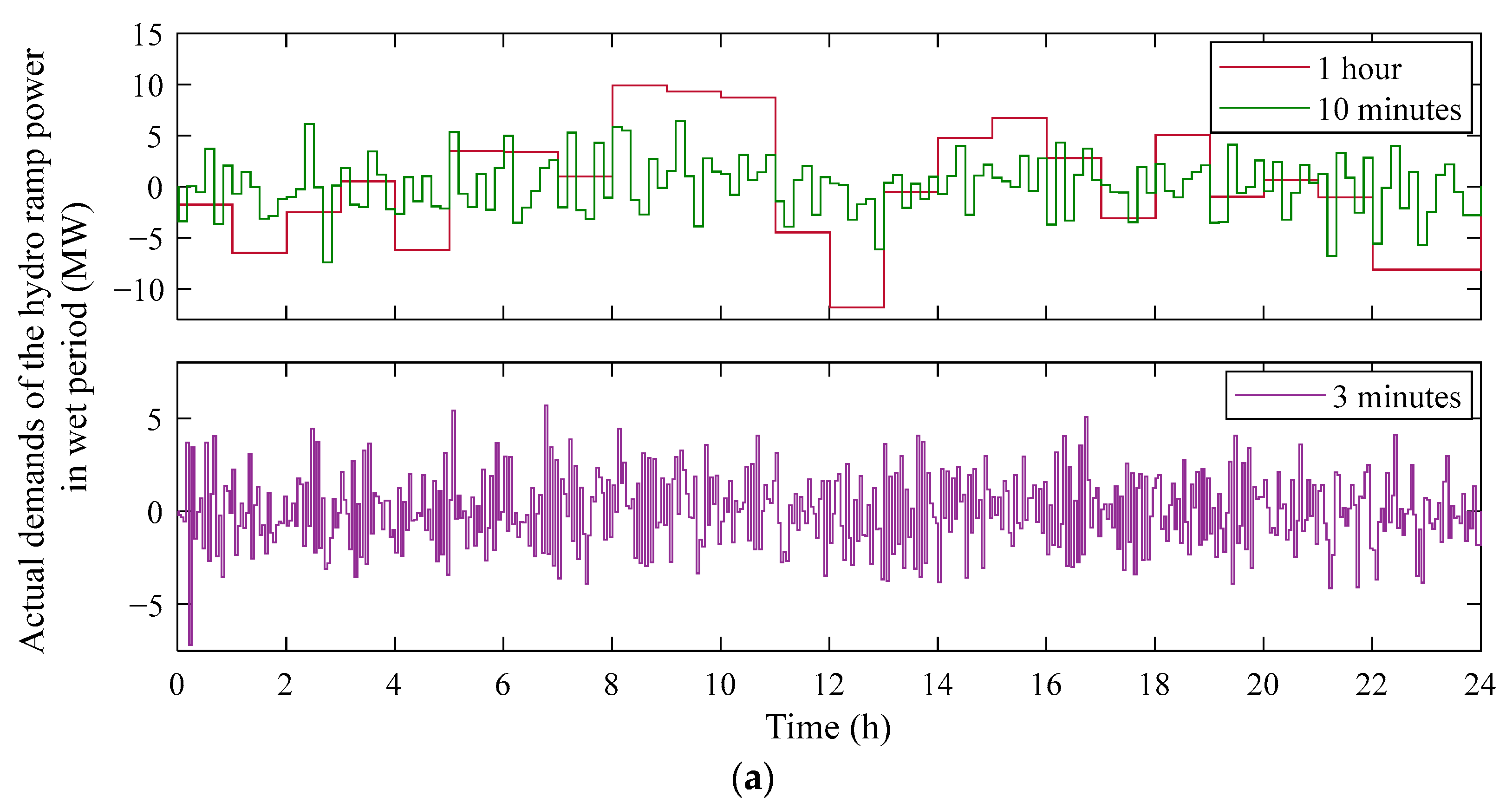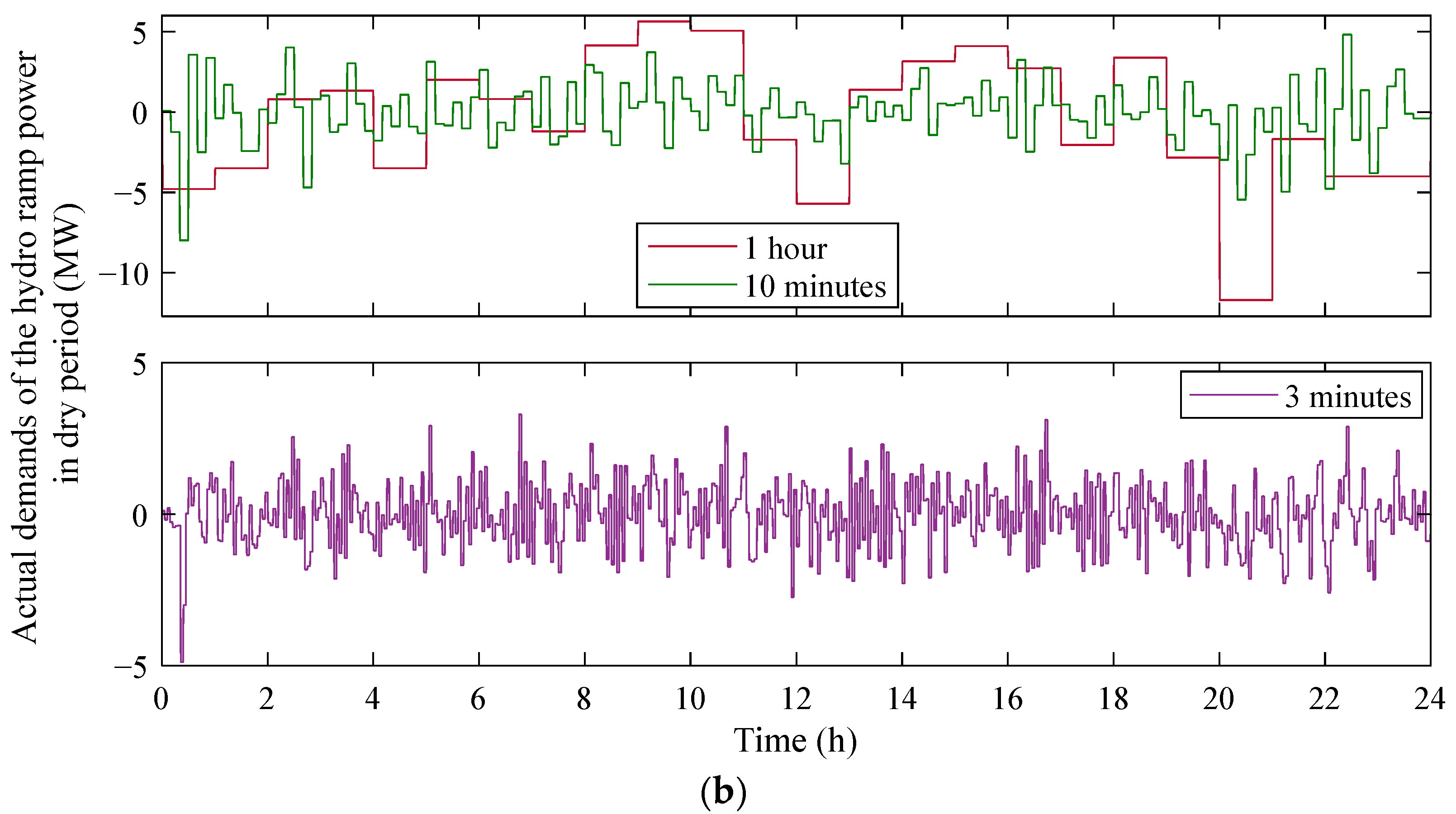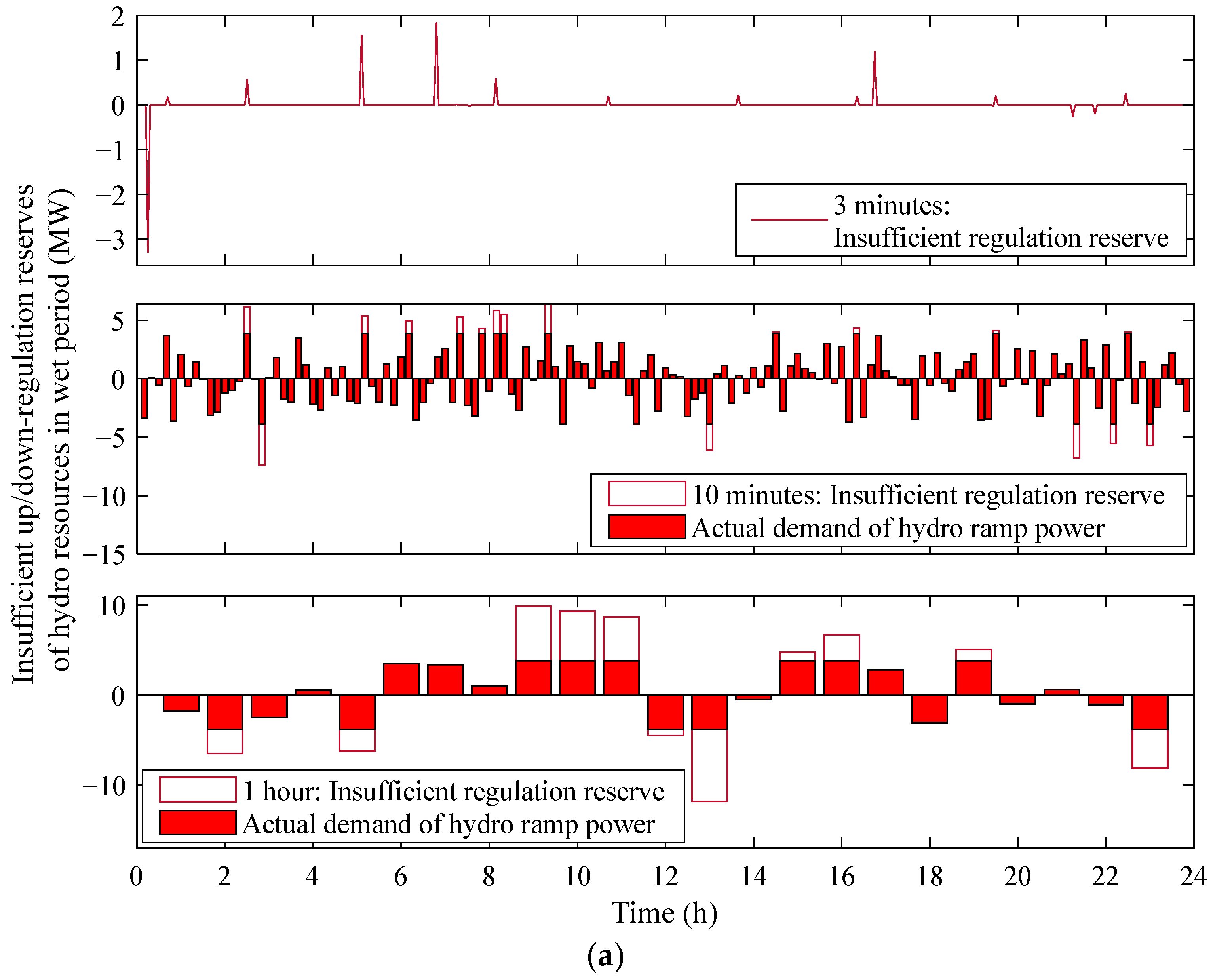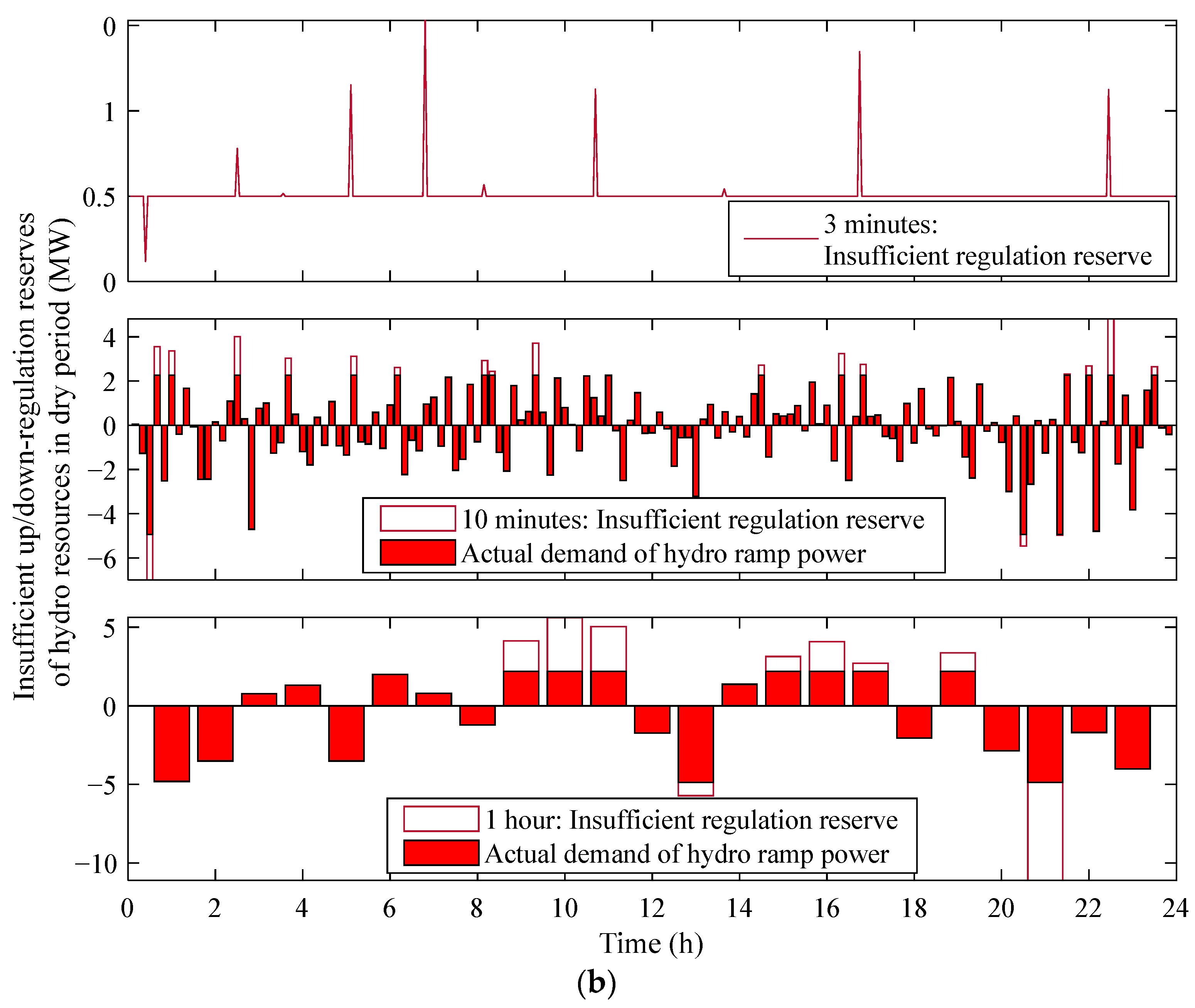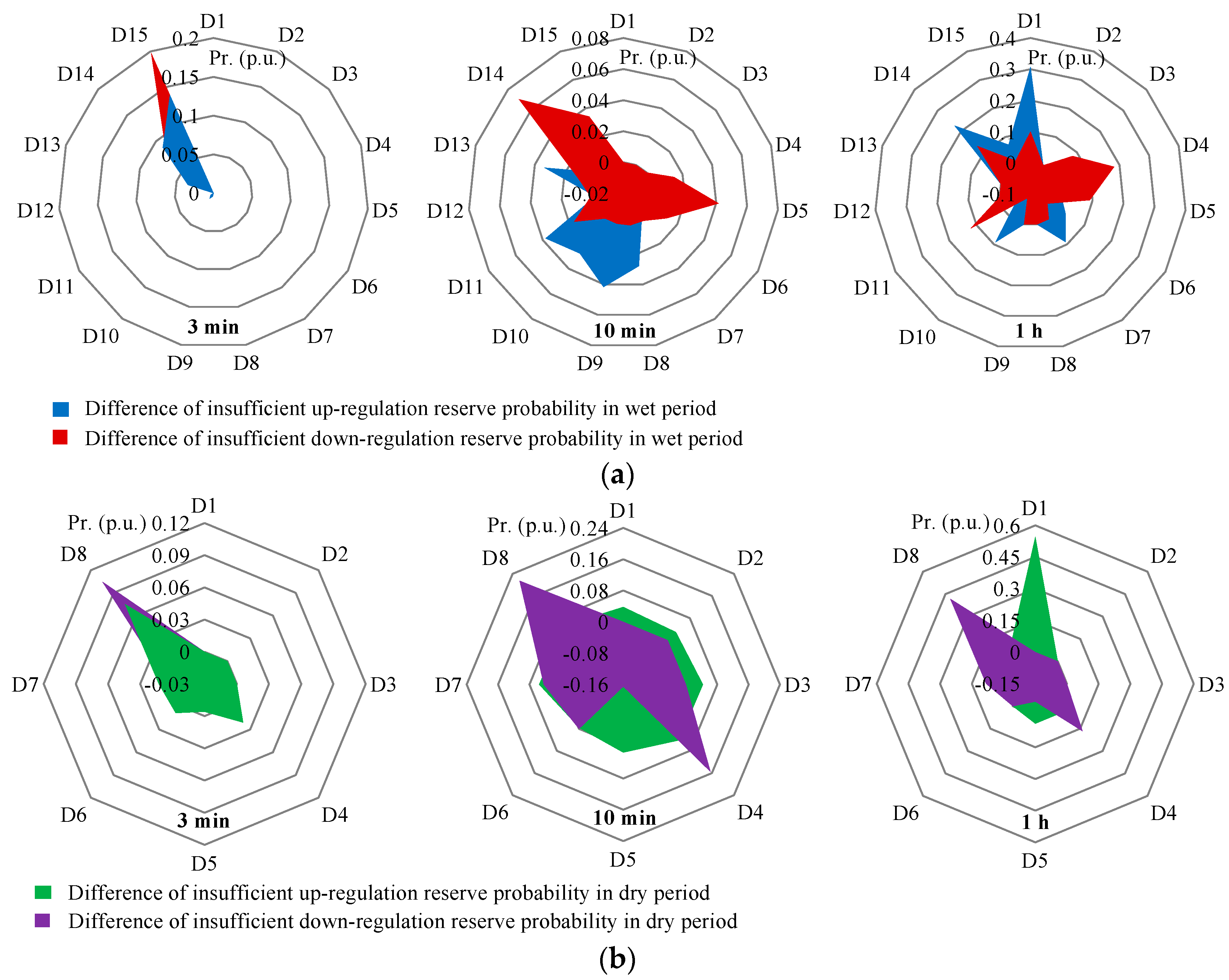Considering the different fluctuations of wind power under the dry and wet periods, the hydro flexibilities for these two seasonal periods in the three time scales are estimated to achieve the optimal coordinated operation.
Section 5.1 clearly shows hydro flexibility of the hybrid power system at any time in 24 h, which helps power plants find the period of time with the high hydropower demands of upregulation ramp power and downregulation ramp power.
Section 5.2 shows the total values of insufficient upward and downward regulation reserves of hydro resources with the change of the proportion of wind power, which helps power plants find the optimal complementary capacity between hydropower and wind power.
5.1. Estimating Hydro Flexibilities under the Dry and Wet Periods
This section uses the method of an equal-time dispatch of the net load to analyze the actual demand of the hydro ramp power and its supply capacity. The insufficient upward and downward regulation reserves of hydro resources are also estimated. The results are shown in
Figure 6 and
Figure 7.
For both wet and dry periods in
Figure 6, the actual demand of the hydro ramp power in 1 h scale is the highest, while this actual demand in 3 min scale is the lowest. Differently, the demand of the hydro ramp power under the wet period is obviously higher than the level under the dry period, which is attributed to the seasonal fluctuations of the water supply and wind speed. In other words, the abundant rainfall and the strong flow of rivers make the reservoir water obviously increase in the wet period, which provides excellent capability of hydro flexibility. Despite this, the randomness of wind power may bring negative impacts on the dynamic power quality of the power system.
Moreover, the high hydro demands of upregulation ramp power and downregulation ramp power under the wet period mainly concentrate on 3.8 MW and 2.8 MW (in the 3 min scale), 5 MW and 5 MW (in the 10 min scale), as well as 9.5 MW and 1 MW (in the 1 h scale), respectively. Conversely, the high upregulation and downregulation ramp demands under the dry period are roughly 1.8 MW and 2 MW (in the 3 min scale), 3.8 MW and 5 MW (in the 10 min scale), as well as 5.5 MW and 6 MW (in the 1 h scale), respectively.
In
Figure 7, the insufficient upregulation reserve of the hydro resource is greater than the insufficient downregulation reserve in different seasonal periods. This means that the hydro flexibility of the ramp up cannot meet the large-scale penetration of wind power. Compared with the wet period, a relatively severe situation exists in the insufficient downregulation reserve under the dry period. For both seasonal periods, the insufficient regulation reserve increases when the time scale changes from 3 min, 10 min, to 1 h. The power system in the time scale of 1 h produces a large amount of insufficient up and downregulation reserves, approximately 10.806 MW and 8.2210 MW in the wet period as compared to 7.4182 MW and 1.3991 MW in the dry period. In contrast, the insufficient up and downregulation reserves are the smallest in the 3 min scale (3.5985 MW and 7.6900 MW in the wet period versus 1.5719 MW and 1.6000 MW in the dry period). The occurrence time of the insufficient reserves is different for the three dispatch scales, which demonstrates the necessity of hydro flexibility from the perspective of timescale variabilities.
5.2. Optimizing the Resource Allocation in Multi-Time Scales
The penetration of wind power in the hybrid system leads to an increased demand of hydro flexibility to improve the power safety. To cope with this challenge, this section investigates the impacts of the increasing proportion of wind power on hydro flexibility. The ultimate access ratio of wind power penetration into the power system is optimized from the calculating results of flexible indicators, which provides a feasible scheme for improving hydro flexibility as much as possible. This flexibility assessment is carried out under three dispatch scales (i.e., 3 min, 10 min, and 1 h) and two seasonal periods (i.e., wet period and dry period). The results are revealed in
Table 2,
Table 3,
Table 4,
Table 5,
Table 6 and
Table 7.
The result in the wet period is shown in
Table 2. For the dispatch scale of 3 min, there is an increased trend for the probability of the insufficient up and downregulation reserves and its related shortfall of hydro reserves when the wind proportion changes from zero to 52.58%. This means that the margin of the system tolerance is at the penetration of 50.70% wind power. Correspondingly, the maximums of wind curtailment and load shedding reach 7.6739 MW along the upregulation direction and 3.9140 MW along the downregulation direction, respectively. For the dispatch scale of 10 min, the flexible indicators IDRP, IUR, and IDR increase between zero and 52.58% wind proportion, while the flexible indicator IURP has two outliers at 45.07% wind proportion (IURP = 0.1333) and 52.58% wind proportion (IURP = 0.1549). However, these outliers cannot influence the increased trend of the shortfall of hydro reserves. In this situation, the margin of the system tolerance is at 52.58% wind proportion. For the dispatch scale of 1 h, there are lots of outliers in IURP and IDRP, which can influence the increased trend of the shortfall of hydro reserves. For instance, if the IDRP rises from 18.78% to 22.53% wind proportion, the corresponding wind curtailment declines from 6.0103 MW to 5.7910 MW. In this case, 50.70% wind proportion is its margin of the system tolerance.
Compared with these three dispatch scales, the wind proportion in 1 h scale has a relatively significant impact on wind curtailment and load shedding. The insufficient up and down regulation reserves reach their corresponding maximums, i.e., 19.647 MW and 11.459 MW, respectively. This is because the decreasing hydro flexibility cannot suppress the large wind fluctuations.
The result in the dry period is shown in
Table 3. For the three dispatch scales, the margin of the system tolerance is at 37.32% wind proportion. Compared with the insufficient downregulation reserve, the insufficient upregulation reserve is a main safety problem for the hybrid power system. Specifically, for the dispatch scale of 3 min, its outliers of the hydro flexibility occur at 24.88% and 29.86% wind proportions, where IURP continuously declines to 0.0246 and IDRP drops to zero. For the dispatch scale of 10 min, the insufficient upregulation reserve generally keeps an increased trend when the wind proportion changes from zero to 37.32%. In contrast, the outliers for the insufficient downregulation reserve occur at 24.88% and 29.86% wind proportions, where both IDRP and IDR drop to zero. The maximal shortfalls of the up and downregulation reserves are 11.433 MW and 12.5157 MW, respectively. Moreover, the maximal probability of the insufficient regulation reserve for 1 h scale exists at 37.32% wind proportion, i.e., IURP = 0.6154 and IDRP = 0.6000. In this dispatch scale, all four flexible indicators change irregularly, and their values are significantly higher than that for the dispatch scales of 3 min and 10 min. The maximal shortfall of the downregulation reserve occurs at 19.91% wind proportion (i.e., 15.604 MW), which is attributed to a long fluctuation cycle of the net load in 1 h scale.
Compared with the wet period, the variation of these four flexible indicators is more complicated in the dry period. The dry period can face a serious hydro flexibility problem. This is caused by the high uncertainties in the water storage and wind speed during the dry period. Meanwhile, the acceptable wind proportion for the wet period (i.e., 50.70%) is obviously greater than that for the dry period (i.e., 37.32%). This illustrates that the wet period has an excellent flexible capability in treating the large-scale penetration of wind power.
Figure 8 further shows the change rate and flexible reserve gap among different wind proportions. The change rate is defined as the difference in the insufficient regulation reserve probability between two adjacent proportions of wind power (e.g., D
i and D
i+1), which represents the sensitivity of the insufficient regulation reserve to the proportion of wind power.
In
Figure 8a, the change rate of the insufficient regulation reserve in the 3 min scale is significantly slower than that in the 10 min and 1 h scales. Specifically, for the 3 min scale, the upregulation change rate keeps at zero between the wind proportion of zero and 30.05%, while the variation occurs in the downregulation change rate from the wind proportion of 45.07% to 52.58%. The corresponding maximums of the upward and downward change rates are 0.1382 (D
15) and 0.1979 (D
15), respectively. For the 10 min scale, the upward and downward change rates start to change at the wind proportions of 26.29% and 11.27%, respectively. Compared with the upward change rate, the downward change rate is relatively faster, and its maximum reaches 0.0704 (D
14). Of note, the negative change rate exists in the insufficient upregulation reserve at the penetration points D
12 and D
15. The negative value represents that the probability of the load shedding reduces between two adjacent wind proportions. For the 1 h scale, the upward and downward change rates start to change from the wind proportion of zero, and their corresponding maximums reach 0.3077 (D
1) and 0.1818 (D
4), respectively. The upward change rate is obviously faster than the downward level, meaning that the upregulation flexibility easily leads to unexpected operational losses in the 1 h scale.
Comparing the dispatch scales of 3 min and 10 min in
Figure 8b, the change rate of the insufficient regulation reserve has an extreme maximum in the 3 min scale, i.e., 0.5455 for the upregulation scenario at the penetration point D
1 and 0.4182 for the downregulation scenario at the penetration point D
8. Thus, the large-scale penetration of wind power has a certain adverse impact on the efficient generation of hybrid power systems. Compared with the wet period, the negative change rate occurs in these three scales in the dry period. Specifically, the negative change rate for the insufficient upward and downward reserves is at the penetration point D
5 in 3 min scale. For the 10 min scale, the negative change rates along the upward and downward directions are at penetration points D
6 and D
5, respectively. With respect to the 1 h scale, the negative change rates along the upward and downward directions are at penetration points D
3 and D
5, respectively. In contrast to the wet period, it is difficult to exactly recognize which flexible regulation direction is the dominant volatility factor in the dry period.
